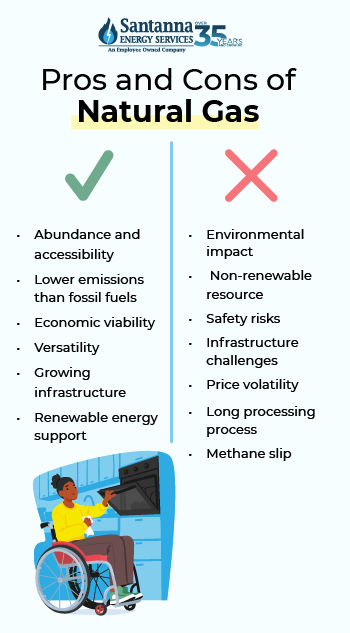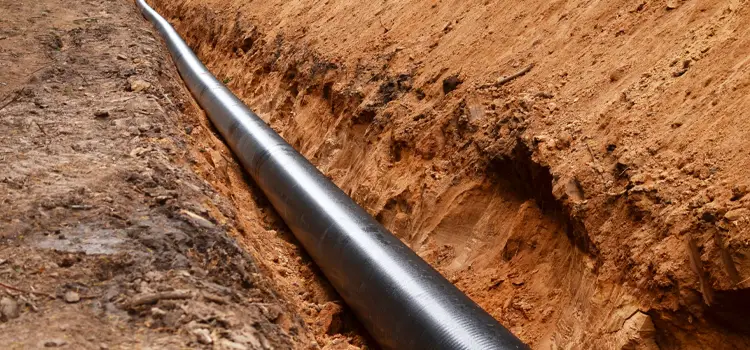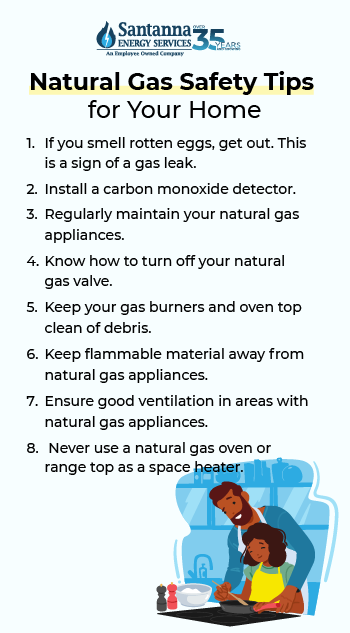Advantages and Disadvantages of Natural Gas
by Tyler Castle
10 min read

In the quest for sustainable and efficient energy sources, natural gas has emerged as a significant player in the global energy market. Known for its versatility and economic viability, natural gas has become a fantastic option for powering homes. However, like any energy source, it comes with its own set of challenges and advantages.
Deciding whether or not natural gas is right for your home is no easy decision. Luckily, we’re here to help by giving you a complete breakdown of a comprehensive list of natural gas pros and cons.
What is natural gas?
Natural gas is a fossil fuel energy source that is composed largely of methane and hydrogen. Natural gas formed from the remains of plants and animals from millions of years ago. Over time, these organic materials were subjected to intense heat and pressure beneath the Earth’s surface. They broke down and transformed into natural gas, which is then expelled and collected for use.
Even though natural gas is considered a fossil fuel, this energy type expels much fewer emissions in the air than traditional fossil fuels. When burned, natural gas emits only half the amount of CO2 into the air compared to coal when producing the same amount of energy.
What is natural gas used for?
People widely use natural gas in homes for multiple purposes. Some of the most common occurrences include:
- Cooking
- Heating your home
- Heating water
- Lighting fires
- Drying clothes

Pros of natural gas
When deciding if switching to natural gas for your home is the right move, you might be wondering: What are the advantages of natural gas? Natural gas offers several key benefits that make it an attractive option for homeowners. Let’s explore some of the best pros of natural gas:
Abundance and accessibility
According to Energy.gov, natural gas is one of the most abundant energy sources in the world. The United States in particular is the world’s leading natural gas producer. In 2022, the U.S. recorded a 10% increase in natural gas reserves for the second year in a row, making natural gas that much more accessible.
In the same way, natural gas can be found in three different places on Earth:
- Large cracks from overlaying rocks.
- In the pores of sedimentary rock formations.
- Alongside crude oil deposits.
With more places to find and extract this energy source, the supply of natural gas remains robust and resilient. This geographical diversity in natural gas reserves means that disruptions in one area can be mitigated by tapping into reserves elsewhere, enhancing energy security.
Lower emissions
A pro of natural gas is its lower carbon emissions. Burning natural gas for energy releases significantly less emissions from all pollutants and CO2 that are expelled from burning this fuel type. To put this in perspective, burning a pound of coal emits 2.07 pounds of CO2 while burning the same amount of natural gas produces only half of these emissions.
Economic viability
According to the E.I.A., natural gas was the single-largest source of energy used to generate electricity in the United States, making up 43% of electricity generation in 2023. Natural gas power plants meet a wide range of requirements across many U.S. markets. Nearly all natural gas-fired power plants are dispatchable meaning they’re able to take on large energy demands.
Natural gas is also 3.3 times more affordable for home heating than electricity. On average electricity averages $46.19 per million BTU while natural gas averages $13.97 per million BTU.
Versatility
As a pro of Natural gas, this energy source can be used for a variety of purposes at home and not. Compared to natural gas-powered stoves, electric stoves take three times as much energy to produce and deliver energy to your stove. Natural gas is mostly commonly for heating purposes (and sometimes cooling too). During periods of power outages, homes that choose natural gas as their preferred power source can rest easy knowing they won’t go without the energy they need.
Infrastructure
Because of natural gas’s growing popularity, extensive networks of pipelines, storage facilities, and distribution systems have been developed to efficiently transport and deliver natural gas. Excess natural gas is stored in underground holding areas which allows for storage of large quantities of gas to be stored.
Another advantage of Natural gas is that natural gas pipelines can transport large volumes of natural gas over long distances with minimal energy loss. Modern pipeline systems are equipped with advanced monitoring and control technologies that enhance safety and efficiency.

Renewable energy support
Renewable energy sources such as wind and solar are intermittent, producing energy only when the sun is shining or the wind is blowing. Natural gas complements renewable energy sources by providing reliable backup power when demand is high.
Additionally, natural gas emits fewer greenhouse gases compared to coal and oil, making it a cleaner alternative. Using natural gas to power your home can reduce your carbon footprint as some energy providers offer environmentally friendly solutions that offset emissions.
Cons of natural gas
When considering if natural gas is the right move for your home, it’s also important to investigate the cons of natural gas. While it offers numerous benefits, such as lower emissions compared to other fossil fuels and a well-established infrastructure, there are also significant disadvantages of natural gas to consider. Here are some of the most common:
Environmental impact
One of the biggest disadvantages of natural gas is its contribution to greenhouse gas production. Natural gas is considered a fossil fuel because of its vast release of methane in the air which is a harmful gas ingredient.
One type of natural gas referred to as shale gas is found deep within the Earth’s crust. To extract this hydraulic fracking is needed to harness this energy. Fracking can lead to disruptions in ecosystems and increase the likeliness of earthquakes.
If this disadvantage of natural gas concerns you like it does us, there are ways to lessen your environmental impact. While we can’t eliminate emissions from natural gas altogether, with an Earth-Friendly natural gas plan for your home, you can offset, or balance out your emissions!
Non-renewable resource
Unfortunately, natural gas is a non-renewable resource. It forms over millions of years from the remains of ancient plants and animals subjected to heat and pressure deep within the Earth. Because this process takes such an incredibly long time, once we use the existing natural gas reserves, they cannot be replenished within a human lifetime. Current reserves have the capacity to last for several decades, but they are not infinite.
Safety risks
While generally safer than coal or oil, natural gas is highly flammable and requires careful handling to prevent leaks. In a home, gas leaks are common and if left untreated, can lead to explosions and health risks. Gas leaks can occur based on a variety of factors, ranging from improper installation to human error. To prevent these accidents from happening in your home, check out our natural gas safety tips!
Infrastructure challenges
Building and maintaining pipelines and storage facilities remains a significant disadvantage of natural gas. Building these pipelines can be costly and face community opposition. Similarly, natural gas pipelines need to be built in areas away from residential zones. Due to these pipelines’ distance from populated areas, certain regions might not have access to natural gas as a power source, even if homeowners are interested in them.
Price volatility
Natural gas prices are constantly fluctuated which at times can cause a high gas bill. Factors like weather patterns, market changes, and supply disruptions are all common causes of spikes in natural gas bills. The best way to combat a fluctuating gas bill is to switch to an energy plan with more predictability. With Santanna’s Unlimited Energy plan, you’re safe from unexpected hikes in your energy bills; the supply portion of your bill won’t change.*
Long processing process
Another disadvantage of natural gas is how long natural gas takes to process. Before it’s ready for residential use, natural gas has other components that must be removed. Natural gas must be purified of elements like water vapor, CO2, sulfur, and nitrogen that can clog up natural gas pipelines. Because this process has so many steps, getting natural gas ready for use can take days and sometimes weeks to do.
Methane Slip
During the handling of natural gas, methane can escape (known as methane slip). Methane is a potent greenhouse gas and can negate some of the environmental benefits of using natural gas. Methane slip can happen anytime it is stored, transported, or used.
Luckily, there are solutions to prevent how much methane slips from this process by using oxidation catalysts. These solutions have been reported to reduce methane slip by 70%.
Tips to reduce your natural gas usage at home
No matter what you choose to power your home, here are a few of our favorite tips to reduce your natural gas usage:
- Use a Programmable Thermostat: Program it to warm up your home just before you wake up or return.
- Improve Insulation: Insulate your walls, attic, and basement to reduce heat loss.
- Maintain Your Furnace: Schedule regular maintenance checks to ensure efficient operation.
- Install Energy-Efficient Windows: Consider double or triple-pane windows to reduce heat loss.
- Use Energy-Efficient Appliances: Choose ENERGY STAR-rated appliances for better efficiency.
- Optimize Cooking Practices: Use a microwave, toaster oven, or slow cooker for smaller meals and cover pots and pans while cooking to retain heat.
- Reduce Hot Water Usage: Take shorter showers and use cold water for laundry when possible.
Using one or more of these approaches can significantly help reduce your natural gas usage. Not only will these practices lower your energy bills, but they will also contribute to a more sustainable and environmentally friendly home.
FAQ’s
Why is natural gas non-renewable?
Natural gas is non-renewable because this energy source is formed from the remains of ancient plants and animals that lived millions of years ago through an intense formation process. Once extracted and used, natural gas cannot be replenished within a human timescale.
Which energy source contributes the least to global warming?
The energy source that contributes the least to global warming as a whole is wind energy. Wind energy is a renewable source of energy that harnesses the power of the wind to generate electricity. Unlike fossil fuels, which are finite resources that will eventually run out, wind energy is constantly replenished by the Earth’s natural processes.
While natural gas is considered a fossil fuel, there are ways to neutralize these carbon emissions through carbon offsetting.
Does natural gas produce carbon monoxide?
If not burned completely, natural gas can produce carbon monoxide. When natural gas is burned in an appliance that is not properly vented, maintained, or operating efficiently, it can produce carbon monoxide, a colorless, odorless, and potentially deadly gas.
How does natural gas get to your house?
Natural gas gets to your house through a three-step journey:
Step 1: The journey begins at the natural gas processing plant where the energy source is purified of any oils, water, or CO2 that might cause harm to natural gas pipelines and homes.
Step 2: Once the gas is ready, the product travels from plants through a network of interstate or intrastate pipelines.
Step 3: Gas from these pipelines is directed into localized systems known as “mains” before it finally enters the service lines that link the mains to individual homes.
For more on the process of delivering natural gas, visit our article for a further deep dive!
Do carbon monoxide detectors detect natural gas?
Carbon monoxide detectors do not detect natural gas. It is also important to note that even most smoke detectors won’t detect natural gas either.
Natural gas detectors do exist and are available at most major retailers like Home Depot and Lowes.
* Restrictions apply. Enrollment based upon program eligibility. Customers using more than 125% of normal monthly usage as determined by Santanna may be required to switch plans.
Tyler is an experienced energy professional, having worked for Santanna Energy Services, for the past four years. He is passionate about renewable energy and believes that diversifying the energy grid is the key to a sustainable future. Tyler is dedicated to supplying consumers with the best possible energy solutions and works diligently to make sure that Santanna can deliver the highest quality service.








